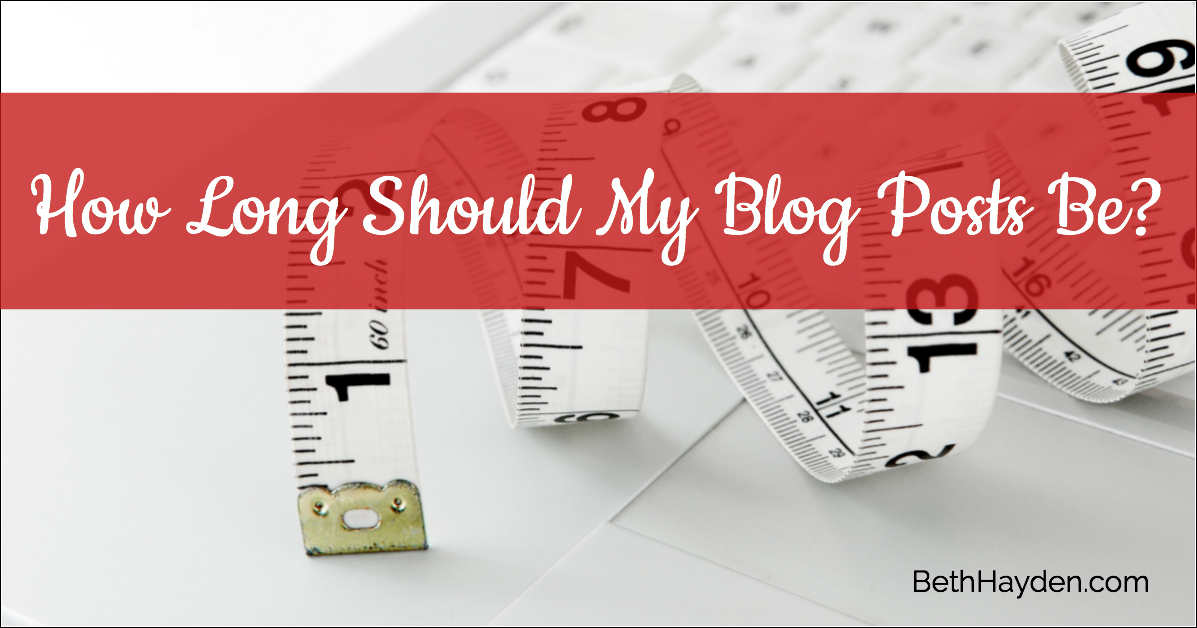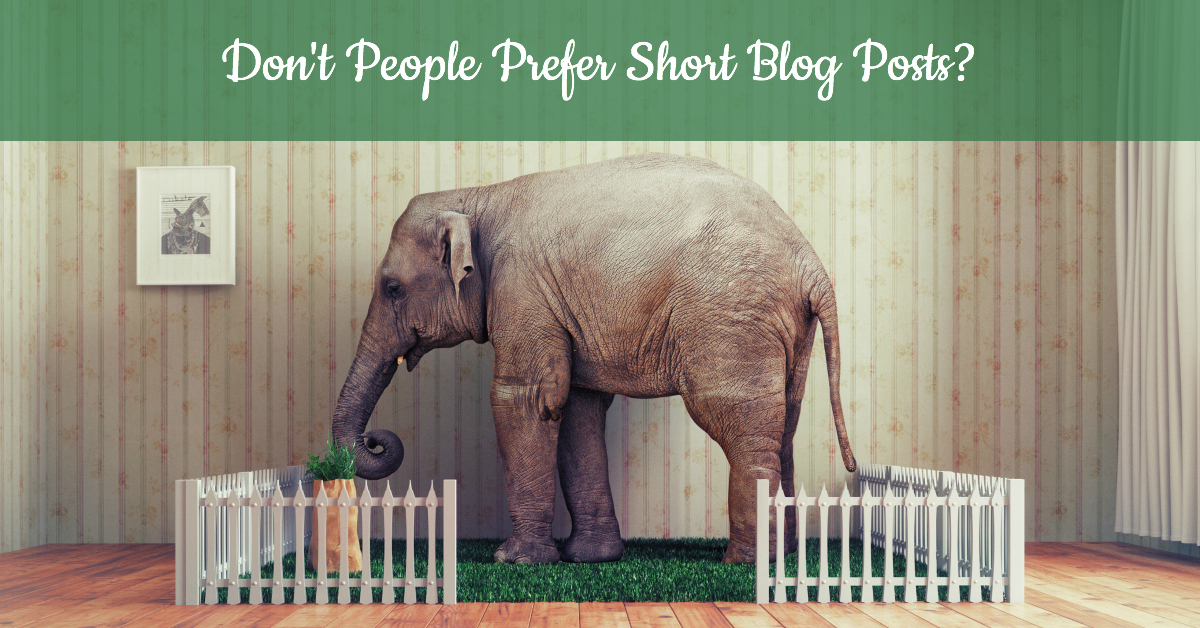When I speak to large groups about blogging, someone in the audience inevitably asks:
“How long do my blog posts have to be?”
The answer to this question is complicated – just like the answer to the previous blogging FAQ, “How Often Should I Publish Posts on My Blog?”
Different popular bloggers have used a number of different post-length strategies on their sites.
On one hand, blogger and author Seth Godin writes short, pithy and concise blog posts on his site. Mr. Godin usually publishes every day, but his posts are typically only 100-200 words long.
On the other hand, Tim Ferriss is known for writing epically blog posts (some are 5000+ words).
Both of these bloggers have developed gigantic audiences over the past few years.
So the answer to this question might see complicated. But I do have a strong opinion about this topic, based on behaviors I’ve seen online and what I’ve read about the kinds of content that search engines prefer.
And I’ll warn you – you may not like the answer I’m about to give. But I urge you to keep an open mind, and I’ll do my best to convince you I’m right. 🙂
3 Reasons You Should Write Long-Form Content
Here’s the truth:
If you want more traffic, comments, social shares and email subscribers, you should create long-form blog post content.
I recommend that bloggers in every niche write blog posts that are at least 1,500 words long — and preferably longer.
Let’s talk about the reasons why you should create longer content.
1. Writing longer posts gives you more opportunities to cover a topic properly, and in detail.
When you write long content (1,500 words+), you have more room to dive into the topic and cover it in depth. It’s difficult to try do a topic justice if you only use 400 words to cover it.
So if you write a tutorial blog post, write a step-by-step, detailed tutorial that explains EXACTLY how to do a certain process. Included exact directions and screenshots, and don’t skip steps.
If you’re writing an opinion piece, explain exactly why you hold the opinion you do. Make people understand why you feel that way, and convince your reader about why they should agree with you.
2. Long-form content attracts more traffic and more comments. If getting traffic to your site is what you want (and let’s face it – we all want that!) then writing long blog posts can definitely help.
You’re also considerably more likely to attract comments for your blog posts if you write longer posts.
3. Google prefers longer posts, so you’ll also get ranked higher in the search engines with long-form content.
The way Google sees it, long content is more relevant because it’s more detailed. And what Google always looks for (and ranks better) is relevant content.
Google also ranks a piece of content higher when OTHER sites link to it. More sites are going to link to your blog post if you cover the topic in-depth and do a bang-up job of covering it detail.
4. Connecting with your reader is usually easier to do in a longer post.
One of the most important things you need to do in a blog post is emotionally connect with your reader.
If you’re only publishing 400-500 word blog posts, you don’t have the time or opportunity to truly connect with your visitors. You don’t have room to write a thought-provoking intro or include stories that evoke strong emotions.
Writing longer posts gives you the opportunity to pull on your readers’ heartstrings or help them see the universal themes in your piece — and readers who connect with your content are more likely to know, like and trust you.
Picture it this way: Long content = more opportunities to connect.
Some Tips on Writing Long-Form Content
Pick the right topic. When you’re choosing a topic for your blog post, you must pick topics that are broad enough to enable you to write a long article. If you’ve written 300 words about your topic and you run out of things to say, it’s likely your subject matter is too narrow, concrete or simple. Complex and/or abstract topics make the best blog post subjects.
Don’t pad your posts with fluff. You should never add fluff to your post so you can reach a certain word count. Fluff will bore your audience and make them click away from your post.
Instead, write a top-quality post that is immensely useful and interesting to your audience. When you’re done explaining, teaching, giving your opinion in detail, stop writing.
Consider publishing less often. If you’re having trouble creating long-form blog articles because you publish posts on your blog three times a week, consider publishing less often.
As we discussed in my previous post, How Often Should I Publish on My Blog?, the quality of your blog posts matters more than the quantity. So don’t kill yourself trying to write 1,500-word pieces three times a week. Publish one outstanding, long-form post every week (or twice a month) instead.
Let’s Talk about the Elephant in the Room
At this point, you may be asking yourself, “Don’t people prefer shorter blog posts?”
On my last webinar, one of my students asked me, “Readers claim they prefer shorter, pithier content. How do you integrate that fact that with your “long form” recommendation?”
She makes a good point. If you ask a typical reader, they will likely tell you they prefer short content they can scan quickly and read in minutes.
But here’s the deal – that’s not the way it works in real life.
Readers like content that answers their questions and solves problems, and that content (most often) is long. Long-form content also gets linked to most often, gets more social shares, and attracts more comments, as we’ve discussed above.
Readers may say they like short content, but their behavior says otherwise.
I’m not saying that people lie — but they may not be fully aware of the length of the content they like, read, share and comment on.
Think about it – when someone you know links to a post on social media, and says, “Read this, it’s awesome,” are you really going to click over to the post and calculate how long the post is before you read it? I know I don’t do that!
When we’re surfing the Internet, we like what we like. It’s pretty unlikely we’re going to read a post and then say, “I didn’t like that because it was too long.” We like what we like, and we share (and link to) that content.
So don’t worry so much about what people say they like. Pay more attention to what’s actually popular online, and what gets a lot of social media shares and comments. Chances are, the popular stuff is long-form content.
Finding the answer that is right for your audience
I could preach the benefits of long-form content all day, but the truth is – you actually need to find out what works best for your audience.
You need to test not only different blog posts lengths, but different types of content (including list posts, interviews, short essays and long form content) to see what your audience prefers.
You have some easy-to-find statistics to help you assess what types of posts your audience likes. To decide how popular a particular post is, look at:
- Your Google analytics data (how many visits does a particular post get?)
- How many social shares a post gets
- How many comments a post gets
To run a test properly, you need to test out several long posts, several short posts, etc. — you’ve got to have a decent-sized sample to get meaningful results.
The topic of your posts also matters, so plan on looking at trends over a 6-12 months period before you make a decision about the length and type of content your audience prefers.
And here’s the key – don’t ask your audience which they prefer (in a survey, or on social media) because people are ALWAYS going to tell you they prefer short posts. Look at their actual behavior using objective data, instead – it’s considerably more reliable!
Creating Your Own Long-Form Content
For some of you, writing long-form content might be difficult, especially if you’re new to it or writing doesn’t come naturally to you. If you help, get a friend, family member or professional editor to help you craft long-form content when you’re getting started.
If you need a little extra help, you can download my writing log tracking templates, which help you learn to write faster by tracking your progress.
So give long-form content a try. I think you’re going to be pleasantly surprised with the results.
Remember: The search engines will appreciate longer posts, and so will your audience – whether they want to admit it, or not. 🙂




13 thoughts on “How Long Should My Blog Posts Be?”
This is fantastic, Beth! I have often wrestled with this question and read a great deal on the topic, but have not had a definitive answer that made sense. I’m going to share this with my counselor community. Thanks!
You’re welcome, Stephanie! I’m glad it was useful for you. Thanks in advance, for sharing it with your counselor community!
Very true about asking people what they want. I once asked an audience if they prefer written blogs posts or videos. They all said “written.” But the videos got a lot more shares and comments. Go figure!
I’d also ask, “Which audience are you writing for?” When you’ve got a smallish list, your most important audience is composed of potential host bloggers who will invite you to post. They go to your blog to assess the quality of your writing.
Excellent point, Cathy! Always good to keep in mind.
Interesting post. Content should be as long as it needs to be to get your points across, and not any longer. I do think people like shorter posts sometimes – having to read long articles can feel daunting on occasions. However, longer posts tend to rank higher in search results than shorter posts. So, it depends on to what extent you are worried about ranking highly in search results. I am aiming for posts in the region of 1,200 – 1,500 words on my blog – not so long that it puts the reader off reading it, but long enough to have a chance of ranking well in Google.
Thanks Beth. This question was lingering in my brain after your great webinar and this explains well. I’ve started watching myself and noting what articles I’m attracted to. I think it depends on whether I am searching for an answer to something–in which case I want a fully-developed article. But in an email newsletter that just brings up a topic, maybe I want it a little shorter because it’s not answering a question I have but introducing me to a topic the author thinks is important (and because they’re an expert, it probably is!) So maybe another option is a short overview to alert the reader to an area of interest, then detail below–and divided by headers so I can skim to where I want. I also agree with Ray, however, that it’s not length just for the sake of word count, but because it’s needed to convey a point well.
Thank you! I run two blogs on a single service business site. One is like an appetizer with individual project stories in lieu of a before-and-after portfolio. These are rather short. The other is more of a main course with longer illustrative discussions.
The longer articles garner much more inbound traffic. The shorter articles – once people get to them – tend to yield more per-session pageviews. I’m trying to get my tags and categories straightened out to cross link relevant posts between the two…as in the “Related articles” list.
I always look forward to your articles. Thanks again.
James, interesting input. I think I get it but to make sure, could you tell me exactly what you mean by “inbound traffic” vs. “per-session page views?”
Thanks for commenting, Ray! Longer posts get shared more often on social media, too – that’s why I always lean toward longer-form content and recommend it for my clients, too.
Hi Mary,
Sorry to be unclear. The longer articles generate more clicks from search results. And the user behavior from there tends to be ‘sideways’ through the site onto other content topics.
When a user gets to the shorter ‘project story’ articles, they tend to move ‘vertically’ down the blog rather than across the site, resulting in a higher number of pages visited during their session (visit) on the site.
Thanks for the clarification. I visited your website and see what you mean now. You seem to be benefiting from a strategy of having both lengths of posts.
It was an excellent question, Mary Collette – thanks for raising this point during my webinar! And thanks for your thoughts here, too. Always good to see you here on the blog!
More of an accident than a strategy though! I started the short form because I wanted to present the projects in a more adaptable format than a typical ‘portfolio’ type page.
Comments are closed.